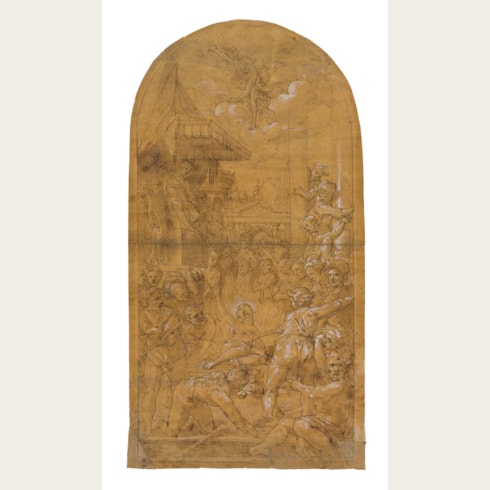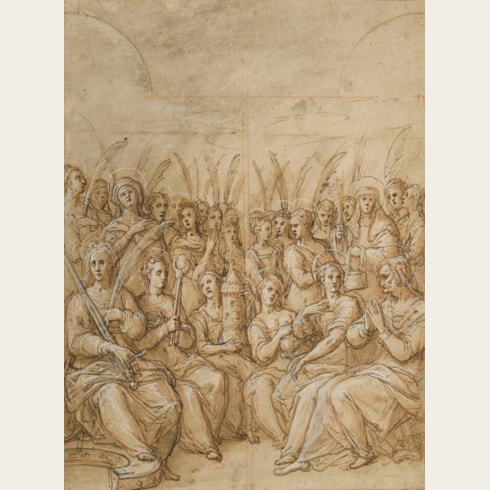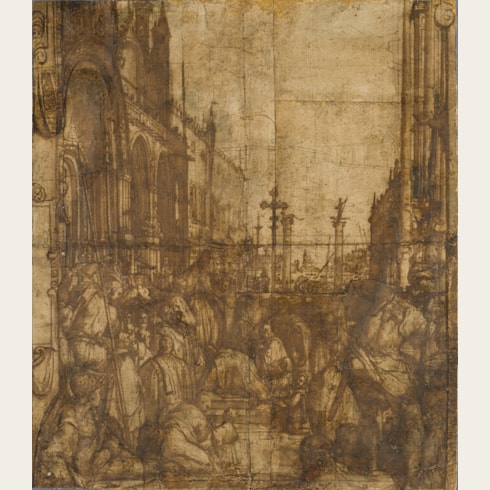Federico ZUCCARO
(Sant’Angelo in Vado c.1540/41 - Ancona 1609)
A Design for a Wall Monument with a Papal Coat of Arms Flanked by Allegorical Figures
263 x 200 mm. (10 3/8 x 7 7/8 in.)
A similar composition is found in a drawing by Federico Zuccaro of a design for a wall monument to Ferdinando I de’ Medici, in the collection of the Milwaukee Art Museum, in which a sculpted bust of the Medici cardinal and future Grand Duke is flanked by allegorical female figures representing Hope and Faith. In both pose and style, the two allegorical figures in the Milwaukee drawing are closely paralleled by those in the present sheet, even to the extent that, like both figures in the Milwaukee sheet, the left-hand figure in this drawing is shown with her foot resting on a sphere.
The handwriting on the verso of the present sheet does not appear to be that of Federico Zuccaro himself.
Federico Zuccaro was among the most well travelled artists of his day. Unlike Taddeo, he travelled throughout Italy, working in Venice, Florence, Orvieto, Bologna, Urbino, Pavia, Turin, Parma and Mantua, while also visiting France, the Netherlands and England between 1574 and 1575. On his return he received a commission to complete the decoration of the cupola of the Duomo in Florence, begun by Vasari and completed by Zuccaro between 1576 and 1579. The next year he was back in Rome, contributing to the decoration of the Cappella Paolina of the Vatican, before departing for Venice, where he worked between 1582 and 1584. He established a particular practice of making drawings after works of art that he saw on his journeys; a sort of visual travel diary that attests to a broad and wide-ranging interest in the different schools of painting in Italy. (As the Zuccaro scholar James Mundy has noted, ‘Federico was completely without prejudice in his omnivorous ingestion of the work of other artists, both past and present.’) In 1585 he was summoned by Philip II to Spain, where he painted eight canvases for the retablo mayor, or high altar, of the Basilica of San Lorenzo at El Escorial, as well as cloister frescoes in the attached monastery. Elected the first principe of the reorganized Accademia di San Luca in 1593, Zuccaro continued to receive important commissions late into his career. He built a fine palace for himself in Rome, now the home of the Biblioteca Hertziana. Near the end of his career he wrote an artistic treatise entitled L’idea de’ pittori, scultori et architetti, published in 1607.
A gifted draughtsman, Federico Zuccaro was much influenced by the drawings of his elder brother, particularly early in his long career. However, as Julian Brooks has noted, ‘Federico’s style was less dramatic than Taddeo’s, and he answered the demands of the Catholic Church for a clearer, more iconic art. His drawings and compositions are tidier than those of Taddeo, with less robust figures, a greater interest in decorative effects, and occasionally complex iconography.’ Furthermore, Federico’s peripatetic career, together with his inveterate copying of the work of other artists, exposed him to a wider range of artistic influences, which often found their way into his drawings and paintings. As Mundy has pointed out, ‘Whereas it would be fair to say that Taddeo’s style was invented in Rome, Federico’s was forged in an international crucible…The wide stylistic range of drawings might be expected but it still, at times, surprises the viewer.’
Provenance
Private collection.
Literature








